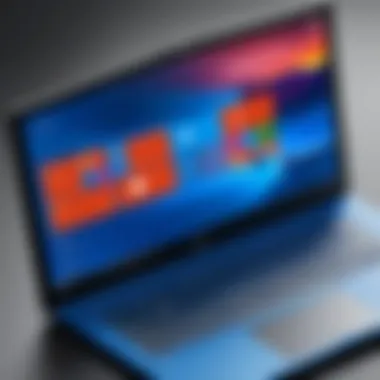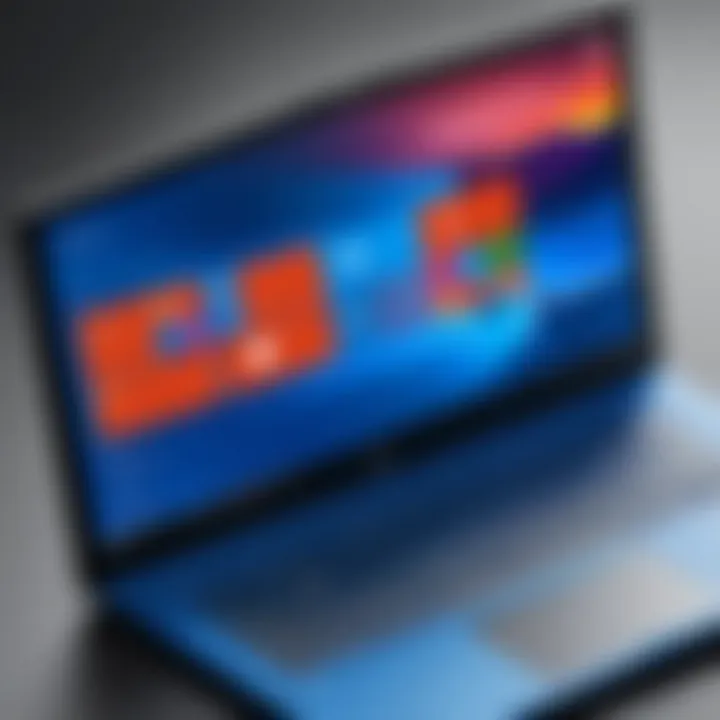Comprehensive Guide to Windows 10 Features and Setup


Intro
Windows 10 is an operating system that has evolved significantly since its launch in 2015. This guide will serve as a comprehensive resource for anyone looking to understand the various facets of Windows 10, from the initial setup to advanced features. Such knowledge is crucial for both personal and professional usage, making the user experience much more efficient.
In the various sections below, we will cover system requirements, installation processes, and essential features that set Windows 10 apart from its predecessors. Additionally, practical tips for optimizing your experience will be provided to ensure you benefit fully from the operating system's capabilities.
By providing clear and actionable information, this guide aims to arm technology enthusiasts and everyday users alike with the tools needed to navigate Windows 10 with confidence. Expect to gain insights into the optimizations and customizations that will cater to your specific needs.
Preface to Windows
Windows 10 represents a significant evolution in the lineage of Microsoft's operating systems. The introduction of this operating system marked a response to changing technology landscapes and user expectations. Its development prioritized user experience, flexibility, and security, setting it apart from earlier versions of Windows. Understanding Windows 10 is essential for anyone who interacts with computers today, whether for work, study, or personal use.
This section will explore the intricate history leading up to Windows 10, shedding light on how past releases have shaped the current environment. Furthermore, an overview of Windows 10's release will illustrate its initial reception and subsequent impact on users worldwide.
Brief History of Windows Operating Systems
The Windows operating systems have a rich and complex history dating back to 1985. Windows 1.0 was Microsoft's first graphical user interface, designed to work on top of MS-DOS. This marked the beginning of a series of developments that aimed to enhance user experience. Over the years, Microsoft released several versions, each introducing new features and enhancements.
Some notable milestones include:
- Windows 3.1 (1992): Popularized multitasking and introduced true type fonts.
- Windows 95 (1995): A groundbreaking release that combined ease of use with a powerful architecture.
- Windows XP (2001): Known for its stability and user-centric design, it gained a large user base.
- Windows Vista (2007): Aimed to enhance security, although it faced criticism for performance issues.
- Windows 7 (2009): Resolved many Vista shortcomings and is still loved by many users.
- Windows 8 (2012): Attempted to unify desktop and mobile experiences but saw mixed reactions.
- Windows 8.1 (2013): Addressed some criticisms of Windows 8 and improved usability.
The culmination of these developments shaped user expectations, paving the way for the next generation operating system, Windows 10.
Overview of Windows Release
Released on July 29, 2015, Windows 10 was presented not merely as an upgrade but as a platform for the future. It reintroduced the Start menu, which had been absent in Windows 8, thus returning to a familiar interface for millions of users. Microsoft branded Windows 10 as the "last version of Windows," indicating a shift towards continuous updates instead of singular new versions.
The initial rollout aimed to create a seamless experience across various devices, whether used for personal or professional tasks. Features like the Cortana virtual assistant and the Edge browser illustrated Microsoft's commitment to innovation.
Windows 10 quickly gained a robust user base, with millions upgrading from Windows 7 and 8. Feedback from users influenced rapid patches and updates, reflecting Microsoft's responsiveness to consumer needs.
"Windows 10 is not just an operating system; it is the last operating system, signifying the shift towards progressive updates instead of radical releases."
The ongoing evolution of Windows 10 continues to demonstrate capabilities aligning with modern user requirements, marking it an imperative focus for anyone engaged with technology.
System Requirements for Windows
Understanding the System Requirements for Windows 10 is essential. This knowledge allows users to assess whether their existing hardware can support the operating system. It also helps in maximizing performance and ensuring a smooth user experience. Without meeting the minimum specifications, users might encounter performance issues or, worse, might not be able to install the OS at all. Having a clear grasp of these requirements is vital for both casual users and tech enthusiasts.
Minimum Hardware Specifications
Windows 10 has set forth specific minimum hardware specifications. These specifications are the baseline that any device must meet to run the OS effectively. Here are the core requirements:
- Processor: 1 GHz or faster compatible processor or system on a chip (SoC).
- RAM: 1 GB for 32-bit or 2 GB for 64-bit.
- Storage: 16 GB for 32-bit or 20 GB for 64-bit.
- Graphics card: DirectX 9 or later with WDDM 1.0 driver.
- Display: At least 800 x 600 resolution.
These minimum specifications ensure that the basic functionalities of Windows 10 can operate. However, performance at these levels may not be very responsive, especially when multitasking or running more demanding applications.
Recommended Hardware for Optimal Performance
To fully enjoy Windows 10 and all its features, meeting the recommended hardware specifications is highly advised. These specifics provide a smoother experience, allowing users to harness the full capabilities of the OS. Here’s a breakdown of such recommended specifications:
- Processor: 1 GHz or faster dual-core or higher.
- RAM: 4 GB for 32-bit or 8 GB for 64-bit.
- Storage: 64 GB or larger hard disk.
- Graphics card: DirectX 12 compatible graphics with WDDM 2.0 driver.
- Display: 1920 x 1080 resolution or higher.
By adhering to these recommended specifications, users can expect better performance, faster application load times, and improved overall system stability. For those engaged in gaming, graphic design, or intensive tasks, a setup that meets or exceeds these requirements can significantly enhance productivity and experience.
In summary, the system requirements are a foundational element when considering Windows 10. Knowing the minimum and recommended hardware can help users make informed decisions about upgrades and installations.
Installation Process
The installation process of Windows 10 is a critical phase for ensuring a smooth user experience. Without a proper setup, usability can suffer, leading to performance issues and functionality limits. Therefore, understanding the steps involved is essential for both new users and those upgrading from previous versions. A successful installation guarantees system compatibility, stability, and access to the latest features.
Preparation Steps
Before diving into the installation, thorough preparation is key. Start by ensuring your hardware meets the system requirements of Windows 10. This includes checking RAM, processor speed, and free disk space. Make backups of important files, especially if you are upgrading, to prevent data loss. It is advisable to create a recovery drive or installation media using a USB flash drive or DVD. Having a reliable internet connection can also facilitate updates. Additionally, research software compatibility to avoid running into issues with existing applications.
- Check hardware compatibility
- Backup files
- Create recovery drive
- Ensure internet access
- Research software compatibility
Step-by-Step Installation Guide
With preparations complete, you can proceed to install Windows 10. Follow these structured steps for a smooth process:
- Insert the Installation Media: Plug in the USB drive or insert the DVD.
- Boot the Computer: Restart your machine and access the boot menu, often by pressing keys like F12 or Esc.
- Select Installation Media: Choose the USB drive or DVD as your boot device.
- Start the Installation Wizard: Once the setup screen appears, select Install Now.
- Enter Product Key: Input your product key; you can skip this for now if you want to activate Windows later.
- Choose Installation Type: Decide between upgrading an existing system or performing a clean installation.
- Partition Selection: Select the drive partition where Windows 10 will be installed.
- Installation Process: Click on Install and wait for the process to complete. Your computer will restart several times.
- Initial Setup: After installation, you'll go through initial setup, including language, regional settings, and creating a user account.
"A proper installation process not only enhances functionality but also sets the foundation for user experience."
Post-Installation Configuration
Once Windows 10 is installed, some post-installation configuration is necessary to optimize performance and security. Begin by ensuring all device drivers are up to date. You can use the Device Manager to check for any warnings on your hardware components. Install essential software and applications based on your needs. Additionally, consider adjusting privacy settings according to your comfort level. Setting up backups from the start can also safeguard data against loss. Regularly check for system updates in Settings to keep your system secure and up-to-date.
- Verify drivers in Device Manager
- Install necessary applications
- Adjust privacy settings
- Setup regular backups
- Check for system updates regularly
This systematic approach to the installation process provides a stable environment to leverage the full capabilities of Windows 10.
User Interface and Navigation
User interface and navigation play crucial roles in how users interact with Windows 10. A well-designed interface enhances productivity and provides a seamless experience, allowing users to access features and applications easily. This section discusses essential elements including the taskbar, Start menu, and File Explorer, all of which contribute to effective navigation and usability.
Taskbar and Start Menu Customization
The taskbar and Start menu are central to navigating Windows 10. Customizing these elements can significantly improve efficiency. Users can pin their frequently used applications to the taskbar for quick access, which reduces the time spent searching for apps.
Moreover, the Start menu can be personalized by adding tiles representing apps, websites, or folders. This customization allows users to arrange their most-needed resources in a way that makes sense for their workflow. For example, a graphic designer might place design software at the forefront, while an office worker could prioritize document-related applications.
To customize the Start menu, right-click on an app tile to resize or remove it from the menu. The settings for the taskbar can also be customized by right-clicking on an open space to access options like locking the taskbar or enabling toolbars. This flexibility leads to an environment tailored to individual preferences.
File Explorer Features


File Explorer is the cornerstone of file management in Windows 10. It provides users with a method for browsing drives, folders, and files. The user interface is straightforward yet powerful, capable of handling simple tasks like moving files or more complex operations such as searching and sorting.
Key features include:
- Quick Access: This section provides shortcuts to files and folders you use most often. You can pin specific items here for instant access.
- Search Bar: It allows users to find files quickly. Simply type the name of the file, and File Explorer will display relevant results.
- Ribbon Interface: The ribbon at the top contains various tabs that group related features such as “Home,” “Share,” and “View,” streamlining workflow.
In summary, File Explorer offers comprehensive tools that enhance file management and navigation.
Settings Menu Overview
The Settings menu is another crucial area for navigation in Windows 10. It consolidates various system settings, making it easier for users to customize their experience. Understanding the layout of the Settings menu can greatly improve user efficiency.
The menu is divided into categories like System, Devices, Network & Internet, and Accounts. Each category contains sub-settings that can be explored for further customization. For instance, the System settings allow users to manage display options, notifications, and storage, while the Network & Internet section enables configuration of Wi-Fi and VPNs.
Users can also search for specific settings using the search bar at the top of the window, which saves time when adjusting configurations. Understanding how to navigate this section effectively ensures users can maintain optimal performance and personalization of their systems.
The intuitive layout and customization options in Windows 10's user interface empower users to tailor their experience according to their needs and preferences.
Navigating Windows 10 becomes less of a chore when users take the time to understand its interface and features. With well-set taskbars, organized File Explorer, and a clear comprehension of the Settings menu, users can optimize their workflow and enhance their overall productivity.
Key Features of Windows
The significance of the key features within Windows 10 cannot be overstated. They are designed to enhance user experience, ensuring both productivity and security. Understanding these features helps users to navigate the operating system effectively, maximizing its potential. This section discusses various functionalities that define Windows 10, catering to different user needs and preferences.
Cortana and Virtual Desktops
Cortana is Microsoft's personal digital assistant integrated into Windows 10. It allows users to perform tasks through voice commands, from searching the web to managing calendar events. Cortana adds convenience to daily tasks, streamlining interactions with the OS. This feature integrates with other applications, making it a versatile tool for users.
Virtual desktops are another pivotal feature. They enable users to create multiple desktop environments, which helps in organizing workspaces. This is particularly useful for those juggling different projects or tasks. Each virtual desktop functions independently, allowing for customized setups tailored to specific activities. Both Cortana and virtual desktops significantly improve multitasking capabilities, fostering productivity.
Windows Store and App Management
The Windows Store serves as a centralized location for users to discover and download applications. This ecosystem promotes a range of software tailored for various purposes, from gaming to productivity tools. The store offers a mix of free and paid applications, ensuring that users can find what they need without much hassle.
Managing apps in Windows 10 is also straightforward. Users can easily uninstall programs that are no longer needed, thus freeing up system resources. Furthermore, the app update process is streamlined through the Store, guaranteeing that users have access to the latest features and security improvements. This aspect enhances the overall user experience, fulfilling the demand for simplicity and efficiency in managing software.
Built-in Security Features
Security is paramount in today’s digital landscape, and Windows 10 includes several built-in features aimed at protecting users. Windows Defender is a comprehensive antivirus and anti-malware tool that runs in the background, providing real-time protection against potential threats. This tool is crucial for users who may not want to invest in third-party security software.
Another essential feature is BitLocker, which encrypts data on the hard drive. This is particularly valuable for business users or those handling sensitive information. With BitLocker, even if a device is stolen, the data remains inaccessible without the appropriate credentials. Windows 10 also regularly updates its security features, addressing new vulnerabilities as they arise. These built-in tools create a safer computing environment, making it easier for users to protect their information.
"The integration of these features ensures that users can enjoy a secure and user-friendly experience, which is critical in current technology use."
In summary, the key features of Windows 10 deliver significant advantages in enhancing usability and security. With its range of tools designed for productivity and protection, Windows 10 remains a compelling choice for both general users and tech enthusiasts.
Performance Optimization Techniques
Performance optimization is crucial for maintaining the efficiency and responsiveness of Windows 10. This section delves into practical strategies that enhance user experience by improving system speed and stability. Effectively managing your system’s performance can result in faster boot times, smoother application usage, and a reduction in system resource consumption. Here are three core techniques to achieve optimal performance:
Managing Startup Programs
Startup programs can significantly impact the time it takes for your computer to boot up and for Windows 10 to become usable. Many applications will automatically configure themselves to start with the operating system, which can slow down the overall boot process. By managing these startup programs, users can free up valuable system resources.
To access startup programs:
- Press Ctrl + Shift + Esc to open Task Manager.
- Navigate to the Startup tab.
- Review the list of programs and disable any that are unnecessary.
Disabling these programs can lead to quicker startup times and improved performance, allowing more resources to be devoted to applications you actively use.
Utilizing Disk Cleanup and Defragmentation
Regularly utilizing Disk Cleanup is key for a healthy system. Windows 10 accumulates temporary files, system caches, and other unnecessary data that can slow down performance. The Disk Cleanup utility can help users reclaim disk space by removing these files.
To perform disk cleanup:
- Search for Disk Cleanup in the Start menu.
- Select the drive you want to clean up.
- Check the categories of files to delete and click OK.
In addition to cleaning up files, defragmenting your hard drive can enhance performance, especially for traditional hard drives. Defragmentation organizes fragmented data, making it easier and faster for the system to access files. Note that this process is not necessary for SSDs, as they do not require defragmentation and may even wear out faster with excessive writes.
Updating Drivers and Hardware Assessment
Keeping drivers updated helps ensure that hardware performs optimally and is compatible with the latest software possibilities. Windows 10 has built-in options to check and update drivers automatically. However, it can also be beneficial to manually check for updates from hardware manufacturers.
To update drivers:
- Right-click on the Start menu and select Device Manager.
- Identify the hardware you want to update, right-click it, and select Update Driver.
- Follow the prompts to search automatically for updated driver software.
Additionally, conducting regular assessments of your hardware ensures that components such as RAM and HDD are functioning correctly. Tools like Windows Memory Diagnostic and chkdsk can identify issues that may be slowing down your computer. Resolving identified hardware issues can lead to a noticeable performance improvement.
Regular maintenance of startup programs, disk cleanup, and driver updates can prolong the life and functionality of your Windows 10 system.
By implementing these techniques, users can sustain a consistently high-performing Windows 10 environment.
Troubleshooting Common Issues
Troubleshooting common issues is an essential aspect of maintaining a smooth user experience on Windows 10. When problems arise, it can disrupt productivity and lead to frustration. Understanding how to effectively diagnose and resolve these problems ensures that users can optimize their Windows 10 experience.
Common issues can range from network connectivity problems to application crashes, or even system update errors. Addressing these issues promptly can enhance system performance and prolong device lifespan. It allows users to make the most out of the features offered by Windows 10.
Network Connectivity Problems
Network connectivity problems are among the most frequent issues users encounter. A disrupted internet connection can hinder access to online resources, affect software updates, and interrupt communication.
Here are some common causes and potential resolutions for network issues:
- Checking Hardware: Ensure that your modem and router are plugged in and operational. Sometimes a simple restart can resolve the issue.
- Network Settings: Navigate to the network settings in Windows 10 by selecting the Wi-Fi or Ethernet icon in the taskbar. Ensure that airplane mode is off and the correct networks are selected.
- Run the Troubleshooter: Windows 10 includes a built-in troubleshooter for network issues. Go to Settings > Update & Security > Troubleshoot > Additional troubleshooters. Here, you can run the Internet Connections troubleshooter to identify and fix common problems.
- Driver Updates: Outdated network drivers can lead to connectivity issues. Regularly check for updates via Device Manager.
In case the problem persists, further investigation might be necessary to explore network adapters or configuration issues.


Application Crashes and Freezes
Application crashes and freezes can be not only frustrating but also detrimental to workflow. When software does not respond, users may lose unsaved work and face interruptions in their activities.
To deal with application-related issues, consider the following steps:
- Update Applications: Ensure that the applications are updated. Many crashes are due to compatibility issues stemming from outdated software. Check the respective application’s settings or the Microsoft Store for updates.
- Close Background Applications: Sometimes, having too many applications running simultaneously can overwhelm system resources. Use Task Manager (Ctrl + Shift + Esc) to close unnecessary programs.
- Reinstall Problematic Software: If an application frequently crashes, reinstalling it can resolve underlying issues. This process clears corrupted files and ensures a fresh install.
- Check for Malware: Malicious software can heavily impact application performance. Keep your antivirus updated and run a full system scan to eliminate any potential threats.
These approaches can mitigate application crashes and improve the overall system stability.
System Update Errors
System updates are vital for security, performance, and the introduction of new features. However, users sometimes face errors during the update process, leading to complications.
To troubleshoot system update errors:
- Run the Update Troubleshooter: Like network issues, Windows 10 has a specific troubleshooter for system updates. Access this via Settings > Update & Security > Troubleshoot > Additional troubleshooters > Windows Update.
- Manual Update Installation: Sometimes, downloading updates manually from the Microsoft Update Catalog can bypass errors encountered during automated installations.
- Check Disk Space: Updating can require substantial storage. Ensure enough space is available on your system drive to facilitate the update process.
- System File Checker: Running the System File Checker tool can identify and repair corrupt system files. Open Command Prompt as an administrator and execute the command: .
Regularly addressing these potential trouble spots can promote a more seamless experience with Windows 10.
By focusing on troubleshooting efforts, users can significantly reduce downtime and maintain optimal workflow, ensuring a robust utilization of Windows 10's full potential.
Advanced Customization Options
Advanced customization options allow users to tailor Windows 10 to their unique preferences and needs. This level of personalization can significantly enhance usability, making it more efficient and enjoyable. Users, particularly tech-savvy ones, often seek to customize settings that align with their workflows. The possibilities range from subtle tweaks to major changes in appearance and functionality.
Benefits of Advanced Customization Options:
- Increased Productivity: Streamlined interfaces allow users to work efficiently.
- Enhanced Visual Appeal: Custom themes can make the operating system more visually appealing.
- Control Over Functionality: Users gain greater control over system performance and features through tweaks.
However, it is essential to approach customization with caution. Some changes, especially to the Windows registry, can lead to instability. Cautions and proper backups are recommended before proceeding with advanced modifications.
Registry Edits for Power Users
Registry editing is a powerful way to customize Windows 10. The Windows Registry is a database that stores configuration settings for the operating system and installed applications. By editing the registry, users can unlock hidden features, change system behaviors, and improve performance.
Before making changes, creating a backup of the registry is critical. Unintentional alterations can cause significant issues. To access the registry editor, type in the search bar. Here are some common edits:
- Disable Lock Screen: HKEY_LOCAL_MACHINE\SOFTWARE\Policies\Microsoft\Windows\Personalization
- Increase Taskbar Transparency: HKEY_CURRENT_USER\SOFTWARE\Microsoft\Windows\CurrentVersion\Themes\Personalize
This level of access provides power users unique capabilities, transforming their Windows experience. Just be mindful of the associated risks.
Creating Custom Themes and Desktop Environments
Customizing themes is about more than just aesthetics—it's also about creating a more personalized workflow. Windows 10 allows users to create custom themes that can change backgrounds, color schemes, and system sounds. Users can also download themes from the Microsoft Store or third-party websites, further diversifying their options.
- To Create a Custom Theme:
- Right-click on the desktop and select Personalize.
- Choose Themes from the left menu.
- Select Background, Colors, or Sounds to customize.
- Save your new set as a theme.
These changes make the desktop more visually appealing and can also improve mood and productivity.
Task Automation with PowerShell
PowerShell is a powerful scripting language and command-line shell in Windows 10. With it, users can automate tedious tasks, manage system administration, and create custom scripts to streamline workflows. By integrating PowerShell into daily routines, individuals can save time and reduce manual errors.
For example, to list all installed applications, you can use:
This capability enables users to perform complex tasks easily, is essential for admins, and enhances efficiency for all users.
In summary, advanced customization options in Windows 10 open a world of possibilities for personalization and efficiency. Caution is essential for certain changes, but the benefits can far outweigh the risks when adequately managed.
Integrating Third-Party Applications
Integrating third-party applications is a vital aspect of the Windows 10 experience. These applications enhance system functionality beyond the built-in features offered. Users can tailor their systems to meet specific needs and improve productivity. The flexibility of Windows 10 allows for the installation and integration of various software solutions.
Essential Productivity Tools
In today's fast-paced environment, productivity is key. Third-party applications can help streamline tasks and improve workflow. Tools like Microsoft Office 365 and Trello provide users with powerful options for document creation and project management.
- Microsoft Office 365 offers a suite of applications that help in creating documents, spreadsheets, and presentations.
- Trello helps in organizing tasks and tracking progress visually.
These tools can boost efficiency and foster collaboration. Also, Slack and Zoom are essential for communication, especially in remote work settings. They provide robust features for messaging and video calls, which can enhance team collaboration.
Customization Software and Utilities
Customization is one of the hallmarks of Windows 10. Third-party software can unlock new levels of personalization. Applications like Rainmeter allow users to customize their desktop experience. It enables users to create custom widgets for time, weather, and system performance.
Additionally, Fences is a useful tool for organizing desktop icons. Users can create designated areas on the desktop to keep applications and files organized.
- Rainmeter: Customizes desktop widgets.
- Fences: Organizes desktop icons effectively.
Using customization tools not only enhances the visual appeal but also improves usability by decluttering the workspace.
Antivirus and Malware Protection Options
Security is a top priority for any operating system. Windows Defender offers a good baseline of protection. However, many users prefer to integrate additional antivirus solutions for enhanced security. Options like Bitdefender and Norton Antivirus provide advanced features.
- Bitdefender offers real-time protection and a user-friendly interface.
- Norton Antivirus ensures comprehensive protection against malware, phishing, and ransomware.
Installing a reputable antivirus solution can help minimize the risks associated with online threats. Regularly updating these tools is crucial. Staying safe requires vigilance in an increasingly connected world.
"Integrating third-party applications is crucial for optimizing Windows 10, ensuring users benefit from enhanced functionality and improved security."
By leveraging these third-party options, Windows 10 users can create a more customized and secure computing environment.
Benefits of Regular Updates


Regular updates are critical to the reliability and efficiency of Windows 10. They encompass various elements that improve security, enhance system performance, and introduce new features. By keeping Windows 10 updated, users can avoid potential vulnerabilities, optimize hardware utilization, and ensure they have access to the latest capabilities. This section emphasizes the multifaceted advantages of regularly updating your operating system.
Enhancing Security with Updates
One of the primary reasons for regular updates is to bolster system security. Microsoft frequently releases updates that patch security flaws and vulnerabilities. Cyber threats evolve continuously, making system updates essential for protection. Regular updates can prevent unauthorized access and potential damage to personal and sensitive data.
- Critical Security Patches: These updates fix known vulnerabilities. Without them, systems remain open to malware and cyberattacks.
- Enhanced Protection Features: New security tools often come with updates. These may include advanced firewalls and threat detection systems that further protect user information.
By maintaining an up-to-date Windows 10 system, users significantly lower their risk of experiencing data breaches or identity theft.
Improving System Performance
Another significant benefit of updates is improved overall performance. Updates often include optimizations that help the system run more smoothly and efficiently. This can lead to a better user experience.
- Bug Fixes: Updates address various software issues that could cause slowdowns or stability problems.
- Resource Management: Updates can include improved algorithms for memory and resource usage, leading to faster application load times and smoother multitasking.
As a result, users experience less frustration with their system's reliability and speed.
Access to New Features
Regular updates also introduce exciting new features and functionalities. Microsoft aims to improve user experience continuously, and updates are a way to roll out enhancements.
- New Applications: Some updates may come with new built-in apps or improve existing ones, enhancing productivity.
- User Interface Improvements: Updates can refine the user experience through visual enhancements or revamped settings, making navigation simpler and more intuitive.
Most notably, users get to access new features that leverage the latest technological trends, keeping their systems current with industry standards.
"Keeping Windows 10 regularly updated not only safeguards against threats but also enriches the user experience with modern functionalities."
Exploring Windows Features for Gaming
Windows 10 is designed to be a versatile operating system, catering to a range of user needs including gaming. The importance of exploring Windows 10 features for gaming lies in how these features enhance the gaming experience, improve performance, and increase accessibility. Users can benefit from functionalities that help optimize system resources, improve graphics rendering, and integrate with gaming consoles.
Game Mode Functionality
Game Mode in Windows 10 is a distinct feature aimed at enhancing the gaming experience. When activated, it prioritizes system resources for gaming applications. This ensures that CPU and GPU resources are utilized efficiently, leading to smoother gameplay. Once Game Mode is enabled, background apps are minimized, reducing interruptions.
To enable Game Mode:
- Open Settings from the Start menu.
- Go to Gaming.
- Select Game Mode and toggle the option on.
It is a simple feature but can significantly impact performance, particularly in graphics-intensive games. Users report improved frame rates and reduced stuttering when Game Mode is active. However, it is essential to note that outcomes may vary based on hardware quality and the specifics of each game.
Graphics and Performance Settings
Optimizing graphics settings within Windows 10 can transform the gaming experience. The operating system accommodates various settings adjustments that users can manipulate for better performance. This includes:
- Resolution: Set the appropriate resolution for your monitor to balance clarity and performance.
- V-Sync: Enabling or disabling V-Sync can help prevent screen tearing but may introduce input lag.
- Render Scaling: Adjusting this setting can increase performance by lowering the quality of the graphics.
Xbox and Windows Integration
The integration between Xbox and Windows 10 is another remarkable feature that enhances gaming. With the Xbox app on Windows 10, users can access a plethora of functionalities:
- Game Streaming: Stream games directly from Xbox to Windows 10.
- Cross-Platform Play: Engage in multiplayer gaming with friends on Xbox.
- Game Pass Access: Xbox Game Pass users can download and play a wide array of games on PC.
Integrating Xbox services also means that achievements and gaming stats can be tracked seamlessly across both platforms. Regular updates to both systems enhance features, making this integration more effective over time.
"To maximize your gaming experience on Windows 10, utilizing Game Mode and adjusting your graphics settings are essential practices. The improved integration with Xbox makes it particularly appealing for gamers."
By leveraging these features, users can ensure a more immersive and enjoyable gaming experience on Windows 10.
Future of Windows Operating Systems
The future of Windows operating systems lies at an intriguing intersection of technological advancement and user expectation. As systems evolve, they must adapt to new user demands, security challenges, and innovation trends. This section explores significant trends in operating system development and anticipated features in future releases. Understanding these elements is crucial for users who wish to stay ahead in the tech landscape.
Trends in Operating System Development
Operating systems are becoming increasingly important in our daily lives, serving as the backbone for numerous devices and applications. Key trends in development are shaping how users interact with their systems.
- Cloud Integration: Many users now expect seamless integration with cloud services. This makes synchronization across devices a necessity. Cloud-based solutions offer users flexibility, enabling access to files and applications from any connected device.
- Increased Focus on Security: Given the rise in cyber threats, security is a paramount concern. Operating systems are expected to come with advanced security measures, such as biometric authentication, enhanced encryption, and automated security updates. Keeping user data safe is a top priority.
- Artificial Intelligence (AI) Utilization: AI has begun to play a significant role in operating systems. From predictive text and voice recognition to more intuitive user interfaces, AI enhances user experience by making systems more responsive and personalized.
- Modular Systems: The trend toward modularity means users can customize their systems better. By allowing users to add or remove features as needed, OS developers can cater to diverse user preferences and requirements.
Overall, these trends indicate a shift towards more personalized, secure, and flexible operating systems that can meet the demands of modern users.
Expected Features in Upcoming Releases
As technology continues to progress, many users are curious about what the next iterations of Windows will bring. Here are several expected features that may define the future of Windows operating systems:
- Enhanced Virtual Desktops: Future versions may offer better management of virtual desktops, allowing users to organize their workspaces more effectively.
- Integrated AI Assistants: While Cortana is already integrated, expect more refined and capable personal assistant features, perhaps with deeper integration into various applications and services.
- Improved Touch and Gesture Support: With the rise in touch-enabled devices, future operating systems may enhance touch and gesture recognition, facilitating smoother navigation and interaction.
- Seamless Gaming Experience: As gaming continues to surge in popularity, features that optimize performance and integrate with gaming networks like Xbox Live are likely to be enhanced in upcoming updates.
- Growing Emphasis on Sustainability: Environmental considerations are becoming important. Future operating systems may integrate more features focused on energy efficiency and resource management.
"As developers focus on creating systems that are not only efficient but also sustainable, users can expect a future of greater accessibility and usability."
Epilogue
The conclusion of this article serves as a critical synthesis of the extensive information presented about Windows 10. It is important because it encapsulates the essential elements of adopting and navigating this operating system. Users can gain clarity on various topics, from system requirements to user interface customization. Understanding these aspects is not just about rote knowledge; it directly impacts how effectively a user can operate within the Windows 10 environment.
By knowing how to optimize their system and troubleshoot common issues, readers can enhance their productivity and overall experience. Regular updates also cannot be overlooked, as they play a significant role in maintaining security and performance. All of these factors contribute to a more seamless interaction with the software.
In short, this conclusion is designed to reinforce the value of the knowledge acquired and its practical applications, ensuring that readers can utilize Windows 10 in a way that meets their specific needs.
Recap of Key Insights
Throughout this guide, several key insights stood out:
- System Configuration: Understanding the minimum and recommended hardware specifications is crucial. This ensures that Windows 10 runs smoothly and efficiently.
- Installation Process: The step-by-step installation guide equipped users with the tools they need to set up Windows 10 successfully.
- User Interface: Knowledge of taskbar customization and File Explorer features is beneficial for efficient navigation.
- Performance Optimization: Techniques such as managing startup programs and performing disk cleanups can significantly enhance system performance.
- Troubleshooting: Familiarity with common issues and their solutions prevents unnecessary frustration.
- Future Trends: By exploring anticipated features, users can stay ahead in their tech journey.
Overall, the insights provided enhance the reader's ability to engage with Windows 10 effectively and proactively.
Encouragement for Continuous Exploration of Windows
The last note is an encouragement for continuous exploration. Windows 10 is not just an operating system; it is a versatile platform that evolves with technology. Engaging with new features, updates, and customization options allows users to leverage the full potential of their systems.
Experimenting with features like Cortana, Virtual Desktops, or even the Windows Store can enrich user experience.
Remaining curious and open to learning will empower you to adapt to changes and innovate in your usage. Engaging with communities on platforms like Reddit can provide additional support and insight. Users should not hesitate to seek out forums, articles, and documentation to further their understanding. The robust landscape of Windows 10 offers endless opportunities for those willing to explore.
"In technology, the more you learn, the more you realize the potential is limitless."







